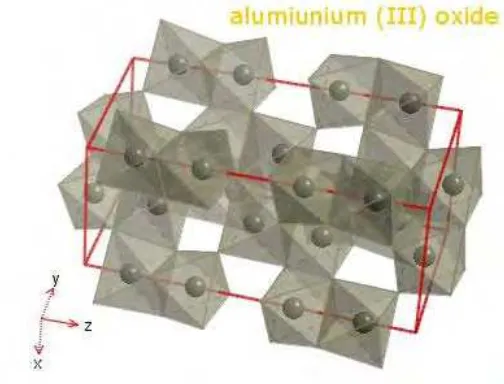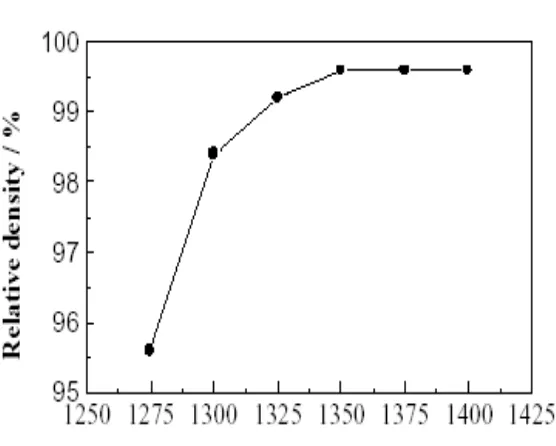DECLARATION
I hereby, declared this thesis entitled
“The Use of Magnesium Oxide (MgO) as Sintering Aid for Alumina Ceramics” is the results of my own research
except as cited in references.
Signature :
Author’s Name : SITI NOR ELYINA BINTI HAJI AB ZARIM
APPROVAL
This PSM submitted to the senate of UTeM and has been as partial fulfillment of the requirements for the degree of
Bachelor of Manufacturing Engineering (Material Engineering). The members of the supervisory committee are as follow:
……… (Dr. Azizah Binti Shaaban)
ABSTRACT
The materials that involved in this experiment were Alumina ceramics and Magnesium Oxide (MgO). Alumina ceramics have high melting temperatures, hot and cold mechanical strength and are good for abrasion and corrosion resistant applications. The main objectives of this study are to determine the effectiveness of sintering aid for alumina where alumina is doping with Magnesium Oxide (MgO). Sintering of alumina products usually occurred at temperature above 1700˚C. Because grain growth of alumina is sensitive to sintering temperature, abnormal grain growth in alumina would occur in the final stage of densification if sintering temperature is too high, which has a great influence on flexural strength and wear resistance of pure alumina increase with decreasing grain size. The process that was conducted for this study was powder processing. The sintering aid, MgO which is added in smaller composition (1%) may enhance sintering process. This was because MgO is controlled the aspect ratio of grains and for better densification. The dopant powder is compacted and sintered at three temperature ranges which were 1300˚C, 1350˚C and 1400˚C. After sintering process, the micro-structural, physical and mechanical properties of sintered product were evaluated by using Scanning Electron Microscopy (SEM), Energy Disperse X-Ray (EDX), hardness testing and Archimedes principle. The result was found that the MgO is effective as sintering aid for alumina ceramics.
ABSTRAK
Kajian ini bertajuk Penggunaan Magnesium Oxide (MgO) sebagai Bahan Pemangkin dalam Pembakaran Alumina, Al2O3 Seramik. Seramik Alumina mempunyai ketahanan
DEDICATION
ACKNOWLEDGEMENTS
Alhamdulillah, praise to God, with the deepest sense of gratitude of the Almighty ALLAH who gives strength and ability to complete this project and thesis as it today.
First of all, I would like to express my unlimited gratitude to my family who has constantly been supportive throughout the project development. They have been the ones gave me strength working on this project until it is complete. I am very grateful having them in my life.
Finally, I would like to thank all my friends and technician who have given me a lot of guidance and help to complete this project. Throughout the study of The Use of Magnesium Oxide (MgO) as Sintering Aid for Alumina Ceramics, their advices and assistance in various ways have been very helpful.
TABLE OF CONTENTS
Declaration………..i
Approval………..………ii
Abstract………..………...……….iii
Abstrak………...iv
Dedication………v
Acknowledgements………...………….vi
Table Of Contents……….vii
List Of Figures………x
List Of Tables………xi
1. INTRODUCTION………1
2.2 Effects of MgO in sintered alumina………..………..……….…….11
2.2.1 Effectiveness in improving mechanical properties……….…….11
2.2.2 Reduced the grain size………..…….……….…….12
2.3 Mechanical Properties……..………..……….…….13
3. METHODOLOGY………..15
3.1 Powder Processing Route ………….………..……….15
3.2 Planetary Milling Machine………….………...…..……….17
3.3 Sieving……..………..……….…….18
3.4 Doping with MgO…….………..……….…….18
3.5 Powder Compaction….………..……….…….19
3.6 Sintering…….………..……….…...…….21
3.7 Sample Characterization………..……….23
3.7.4 Physical Observation…………..……..………..….27
4.3.3 Microstructure Observation.………..…………..………….…...35
4.3.4 Physical Properties.………...………..…………..……...38
2.1 Effect of sintering temperature on relative density of alumina ceramics 9 2.2 SEM photographs of the fractured surface of alumina ceramics
sintered at (a) 1300˚C (b) 1400˚C
10
2.3 SEM micrographs of aluminas sintered with MgO 12 2.4 Effect of sintering temperature on flexural strength and erosion rate 13 2.5 Vickers hardness vs. sintering temperature 14
.
3.1 Flow chart of Powder Processing 16
3.2 Planetary Ball Milling Machine 17
3.3 Hydraulic Hand Press machine 19
3.4 Tube Furnace for sintering process 21
3.5 Sequences of Operations in a Sintering Furnace Scanning 22
3.6 Scanning Electron Microscopy (SEM) 24
3.7 Diamond Cutter machine 24
3.8 Element Characterization 25
3.9 Vickers Test 26
3.10 Densimeter machine 27
4.1 SEM Micrograph of Alumina mixture 30
4.2 Compacted Alumina 32
4.3 Pallet ready for sintering in Tube Furnace 33 4.4 Image of unsintered and sintered product 34 4.5 SEM Micrograph of AL1300 (sintered at 1300°C) 36 4.6 SEM Micrograph of AL1300 (sintered at 1350°C) 36 4.7 SEM Micrograph of AL1300 (sintered at 1400°C) 37 4.8 Image if Diamond indenter of Vickers Hardness Test 41
1.1 Alumina Oxide (Al2O3) Properties 4
3.1 Observation Table 23
4.1 Elements in MgO 29
4.2 Composition of dopant Alumina 31
4.3 Data of sintered body 39
LIST OF ABBREVIATIONS, SYMBOLS, SPECIALIZED
NOMENCLATURE
Al2O3 - Aluminum Oxide CIP - Cold Isostatic Pressing CaO - Calsium Oxide
EDX - Energy Disperse X-Ray
EPA - Environmental Protection Agency Fe2O3 - Iron (III) Oxide
CHAPTER 1
INTRODUCTION
1.1 Materials Background
Ceramics are diverse group of nonmetallic, inorganic solid compounds with a wide variety
of compositions and properties. Ceramics are crystalline compounds consisting of metallic
and nonmetallic elements whose properties differ from the constituents. Ceramics in
general are hard, brittle and stiff. They are generally higher in compressive strength than
tensile. They are totally elastic, meaning they exhibit no plasticity when a load is applied.
There is little or no deformation prior to fracture and they have the highest melting points
of any materials.
Magnesium oxide, or magnesia, is a white soli
and is a source of
formed by a
easily made by burning magnesium ribbon which oxidizes in a bright
in
→ Mg(OH) 2), but it
In medicine, magnesium oxide is used for relief for heartburn and sore stomach, as an
antacid, magnesium supplement, and as a short-ter
symptoms of
cramping. It is used also as a basi
Alumina which is also known as Aluminum Oxide is an amphoteric oxide of aluminum with the chemical formula Al2O3. Alumina was taken off the United States Environmental Protection Agency's chemical lists in 1988. The largest manufacturers in the world of Alumina are Alcoa, Alcan and Rusal which is specialize in the production of specialty Alumina.
Aluminum Oxide or Alumina is one of the most versatile of refractory ceramic oxides and finds use in a wide range of applications. Alumina is one of the important engineering ceramic materials because of its high-temperature stability and the retention of strength at high temperatures and cheap starting powder. Especially in recent years, high purity Alumina ceramics are more widely used for tribological applications such as grinding tools and grinding media.
1.1.1 Structure of Alumina
The most common form of crystalline Alumina, α-aluminum oxide, is known as
structure. There are more than 25 different solid phases, or forms, have been described as γ, θ, κ, χ, δ and η. Alumina occurs in two crystalline forms.
formed by crushing crystalline Alumina where it is white when pure. Dense Alumina microstructures with grain sizes of about 0.5 µm are common products of the grinding industry.
Figure 1.1: Structure of Alumina
Source:
1.1.2 Properties of Alumina
Among the oxide ceramics, Alumina, Al2O3, is the most commonly used ceramic because
of its high hardness, wear resistance, high modulus, inertness, refractoriness and adequate
strength. Some of the properties of Alumina are displayed in Table 1.1. Paradoxically, the
development of high purity Alumina ceramics was driven not by their structural
application but by the need for low electrical conductivity insulators.
properties. For example, spark plugs are made using high Alumina porcelain about 90% for its insulating properties coupled with its strength, heat and thermal shock resistance.
High purity of Alumina ceramics can provide such good resistance to chemical attack that can resist hydrofluoric acid and molten alkalis and alkali vapors. The chemical inertness of these same bodies make them ideal for making valves and seals exposed to severe corrosive and abrasive conditions. Alumina ceramics also resist the effects of radiation that can destroy other materials. Alumina ceramic can have very high dielectric strength, high resistivity and low dielectric loss.
Alumina is generally white but is sometimes pink (88% Alumina) or brown (96% Alumina). The color is derived from either the sintering additives or impurities in the raw materials. Good to chemical stability of Alumina, leads to a high corrosion resistance. It is insoluble in water and only slightly soluble in strong acid and alkaline solutions.
Table 1.1: Alumina Oxide (Alumina) properties
ELEMENT VALUE
Sintered Density 3.97 g cm−3, solid
Melting Point 2050 °C
Nominal Grain Size 5 μm
Tensile Strength(MPa) 620
Young’s Modulus (GPa) 380
1.1.3 Applications of Alumina
Alumina powders, that sinter at as low temperature as possible are needed for production of prime quality multilayer substrates for ultra large-scale integrated circuits. Simple yet precise systems for locating pores and controlling pore size must be developed. For the electronics grade Alumina, an extremely severe linear shrinkage tolerance (±0.15%) in sintering is required.
In the field of refractoriness, efforts to develop new or improved Alumina based raw materials will be continued. These products are required to meet the ever-increasing severity of service conditions in the steel and other industries utilizing refractoriness. Polycrystalline Alumina will continue to be used successfully as an artificial bone implant material for body joints and other parts. In biomedical, high purity Alumina are used as orthopedic implants particularly in hip replacement surgery. Tooth implants made on single-crystal Alumina will become more common in the future because of their strength. There are various example applications of Alumina ceramic in Figure 1.2.
Alumina is also the byproduct of hydrogen generation for the purposes of fuel generation when water is added to pellets comprised of aluminum and gallium. The other byproduct of the reaction is of course gallium.
Figure 1.2: Various application of Alumina ceramic Source: Morgan Advanced Ceramics Inc. (2007)
1.2 Objectives
1.3 Problem Statement
Ceramic powders are particulates, usually with a micron or mesh size distribution, fabricated through atomization, crushing, milling, precipitation or other processes. Sintering of Alumina products usually occurred at temperature above 1700˚C. Because grain growth of Alumina is sensitive to sintering temperature, abnormal grain growth in Alumina would occur in the final stage of densification if sintering temperature is too high, which has a great influence on flexural strength and wear resistance of pure Alumina increase with decreasing grain size.
CHAPTER 2
LITERATURE REVIEW
2.1 Sintering
Sintering is a processing technique used to produce density-controlled materials and components from ceramic powders by applying thermal energy. Sintering will affect certain parameter during the process such as their purity, density and sintering temperature.
All the characteristic temperatures associated to phase’s transformation, glass transitions and melting points, occurring during a sinterisation cycle of a particular ceramics formulation can be easily obtained by observing the expansion-temperature curves during
2.1.1 Purity
Rao et al. (1999) investigated that sintering temperature for Alumina densification usually increases with increases of its purity. If high purity Alumina powders are prepared by traditional methods, the sintering temperature should be over 1700˚C to get dense Alumina sintered body. Because grain growth of Alumina is sensitive to sintering temperature, abnormal grain growth in Alumina would occur in the final stage of densification if sintering temperature is too high, which has a great influence on flexural strength and wear resistance of pure Alumina increase with decreasing grain size. In recent years, high purity Alumina powders prepared by chemical methods enable them to sinter at temperatures lower than 1600˚C.



